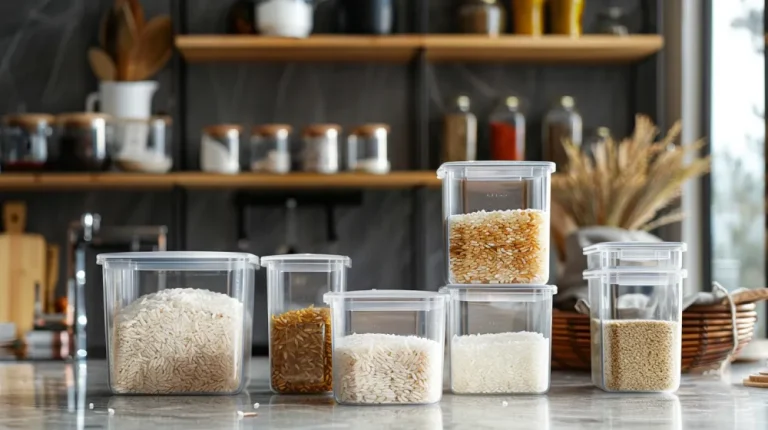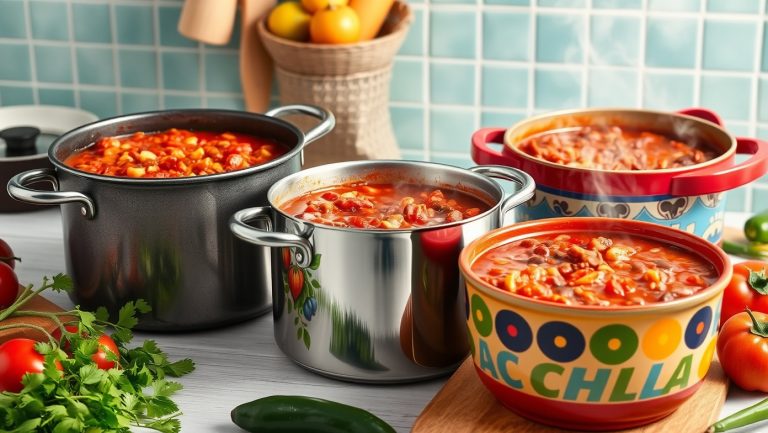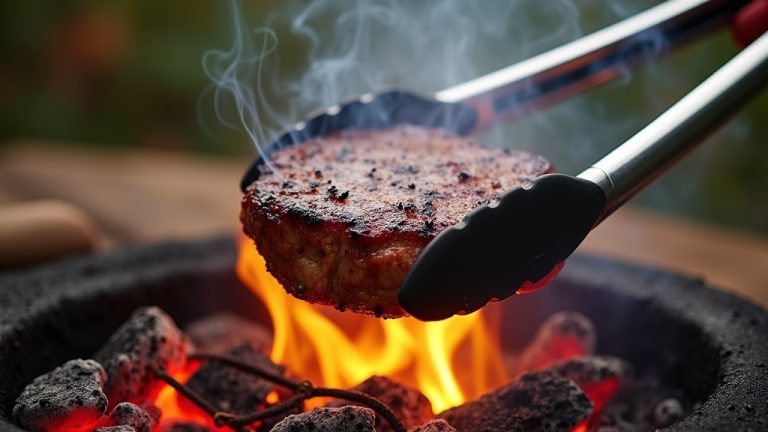Chicago Cutlery Review: Are These Knives Worth Buying?
If you’re after affordable, traditionally styled knives suitable for everyday cooking, Chicago Cutlery offers decent starter sets with comfortable handles and acceptable sharpness.
However, their blades dull relatively fast and need frequent maintenance. Quality control can be inconsistent, especially since much production moved overseas.
They’re best for light home use rather than heavy-duty tasks or professional kitchens. If you want a clearer picture of their materials, performance, and who they’re ideally made for, keep exploring their detailed features and reputation.
- ALL IN ONE: The 17 Piece set includes a 7-3/4″ Chef knife, 7-3/4″ Serrated bread knife, 7″ Santoku…
- MADE TO LAST: Long-lasting sharpness perfect for frequent cooking and peace of mind.
- SAFE HANDLING: Asian-influenced, cushion-grip handles provide a sturdy, non-slip grip.
Key Takeaways
- Chicago Cutlery offers affordable kitchen knives with traditional designs, suitable for everyday home cooking and beginner culinary use.
- The brand’s knives feature high carbon stainless steel blades, often stamped with full tang and triple-riveted handles for durability.
- Quality has declined due to overseas manufacturing shifts, resulting in less robust construction and more frequent sharpening needs.
- Product range includes versatile sets with chef, utility, paring, and steak knives, often bundled with blocks and built-in sharpeners.
History and Origins of Chicago Cutlery
The history of Chicago Cutlery begins in 1930 when two Italian immigrants, Sam Asadorian and Joe Prosek, founded a knife sharpening service in Chicago, Illinois. You’ll find their early shop at Fulton and Jefferson Streets focused on sharpening knives for butchers and local industries.
As demand grew, they shifted toward manufacturing their own knives, introducing stamped knives that balanced quality and affordability. This provided an alternative to pricier handmade options. By 1969, Chicago Cutlery expanded its presence through catalogs and retail, reaching both households and professionals.
You’ll notice the brand’s roots tied closely to Chicago’s industrial heritage, with all initial manufacturing in the city. The company also became known for developing Damascus blades with multiple layers of steel, enhancing both strength and corrosion resistance.
Compared to other brands, Chicago Cutlery carved a niche with budget-friendly, reliable knives. They emphasized practicality without sacrificing craftsmanship, often utilizing stainless steel material to ensure durability and ease of maintenance.
Ownership and Manufacturing Changes
Have you noticed how Chicago Cutlery has changed hands quite a bit over the years? It started with Mastercraft, then moved on to World Kitchen, and later Corelle Brands. Now, it’s under the umbrella of Instant Brands. Quite the journey, right? This evolving ownership has influenced the brand’s manufacturing standards and product focus.
Along with these ownership changes, production has gradually shifted from Chicago to overseas factories, mainly in China. This transition has had a big impact on manufacturing costs and how the products are positioned in the market. Originally made in Chicago, Illinois, all products are now manufactured in China, leading to a decline in quality and positioning the brand as mid-range with good value.
It’s all about finding that sweet spot between affordability and the evolving quality standards we expect today.
Ownership Transitions Overview
How did Chicago Cutlery evolve from a regional manufacturer to part of a global kitchenware conglomerate? Initially rooted in Minneapolis since 1932, Chicago Cutlery grew from sharpening butcher knives to retail products by 1969.
Its ownership shifted markedly after becoming part of Lifetime Brands, which expanded through acquisitions like Farberware and Pfaltzgraff. Later, Lifetime Brands merged with Corelle Brands, placing Chicago Cutlery under global corporate management.
Ensuring product quality and durability is essential, similar to how manufacturers use techniques like material and design selection to maintain high standards.
| Period | Ownership |
|---|---|
| 1930–1969 | Independent, Minneapolis-based |
| 1970–2000 | Acquired by Lifetime Brands |
| 2000–Present | Under Corelle Brands (Instant Brands) |
These shifts broadened Chicago Cutlery’s market but centralized control, reflecting a move from regional identity to global conglomerate ownership.
Shift to Overseas Production
Several significant changes in ownership during the late 20th century directly influenced Chicago Cutlery’s shift from U.S.-based manufacturing to overseas production. The original American Cutlery Co., established in 1865 in Chicago, was known for its high-quality steel knives and domestic craftsmanship, which set a standard that later ownership changes moved away from.
As larger conglomerates acquired the brand, they prioritized cost reduction to remain competitive, moving production to China and Taiwan. This strategic move often resulted in less frequent regular maintenance, which is essential for preserving knife performance and safety.
This evolution aligned with industry trends but altered product quality and materials compared to the original American-made knives.
You’ll notice:
- Manufacturing relocated from Chicago to China and Taiwan for affordability.
- Use of lower-grade steel and more plastic in handles increased.
- Heat treatment and blade tempering standards declined.
- The brand shifted from premium to mid-range market positioning.
This shift reflects strategic business decisions balancing price competitiveness with acceptable performance rather than maintaining the earlier domestic craftsmanship.
Quality and Performance Overview
Chicago Cutlery blades are crafted from mid-quality stainless steel, which means they provide decent sharpness. However, you’ll need to put in some regular maintenance to keep them performing effectively. It’s a bit of a trade-off, really. Regular care, such as cleaning and drying the blades properly, helps maintain their sharpness and durability.
Now, let’s talk about the handles. They’re designed for comfort with a contoured stainless steel grip. But here’s the catch—some users have mentioned experiencing grip issues, mainly due to the shape and fit. It’s something to consider if you’re particular about how a knife feels in your hand. The handles often benefit from minor modifications like sanding or reshaping to improve comfort and grip.
When it comes to durability and how easy they’re to sharpen, these knives do a solid job for everyday tasks. However, if you’re looking for the longevity and edge retention that comes with premium brands, you might find Chicago Cutlery lacking in that department. Edge retention is generally moderate, and these knives tend to lose sharpness relatively quickly during extended use.
Blade Material Quality
Although Chicago Cutlery offers knives with varying steel grades, their primary use of high carbon stainless steel strikes a balance between strength and corrosion resistance that you’ll appreciate in daily kitchen tasks.
This steel typically provides better hardness and edge retention compared to lower-grade 420 stainless steel found in some budget lines. However, exact steel specifications vary by line and manufacture date, so performance may differ.
Many high carbon stainless steels contain around 14-17% Chromium, which significantly enhances corrosion resistance. The blades resist rust thanks to chromium content but require proper care to avoid corrosion from the high carbon element.
Chicago Cutlery’s edge design further complements the material quality, delivering precise cuts. Additionally, proper maintenance is crucial to preserve the blade’s performance and longevity, similar to recommendations for long-lasting cookware.
- High carbon stainless steel balances sharpness and rust resistance
- 420 steel variants need more frequent sharpening
- Chromium content (14%+) protects against corrosion
- Edge retention supports consistent cutting performance
Handle Comfort and Grip
When selecting a knife, handle comfort and grip play an essential role in ensuring control and reducing fatigue during use.
Chicago Cutlery offers diverse handle materials, from lightweight polymer in the Metropolitan collection to classic solid walnut in the Walnut Tradition set.
Sleek stainless steel is available in the Malden and Insignia Steel lines. Most handles feature ergonomic, contoured shapes with triple-rivet construction, enhancing stability and fit. The company’s knives are currently manufactured in China, which may affect overall handle quality and consistency.
Soft-grip and cushion grip technologies reduce hand strain during prolonged tasks, while vented parer handles improve dexterity. Proper care and maintenance, including cleaning and drying handles, can help extend their lifespan and maintain handle performance.
Although boxier handles may challenge pinch grips, the majority provide secure, non-slip holds. Walnut handles deliver warmth and comfort, contrasting with the contemporary feel of stainless steel.
Sharpening and Durability
Since Chicago Cutlery knives typically feature a relatively steep 26° inclusive sharpening angle, you can expect enhanced edge durability at the expense of an initially less keen edge compared to premium knives sharpened at lower angles.
This edge geometry balances toughness and performance but demands more material removal during sharpening, especially when repairing chips.
The mid-range 440C or 420C stainless steel used is hard, requiring patience and moderate pressure with stones or slow-speed belt sanders. During sharpening sessions, attention to belt condition is important as worn belts require more effort and reduce efficiency. Using ergonomic handles on sharpening tools can also reduce hand fatigue during prolonged maintenance.
Regular maintenance with honing steels and proper sharpening techniques prolongs edge life.
Keep in mind:
- Steep angle improves edge retention, tolerating kitchen wear.
- Sharpening demands multiple grit stages for restoration.
- Pull-through sharpeners risk uneven edges and missed heel areas.
- Reprofiling chips shortens blade lifespan if overdone.
You’ll find these knives durable yet needing consistent care for ideal performance.
- 18 PIECES: The Chicago Cutlery Insignia set features 17 specialty knives and 1 pair of scissor -…
- BUILT IN SHARPNER: With a unique built-in sharpener in the acacia wood block, the Insignia knife set…
- 26 DEGREE TAPER: The blades on all the knives are made with a 26 degree taper grind edge, providing…
Materials and Construction Details
Chicago Cutlery uses a variety of materials and construction techniques to balance durability, sharpness, and comfort. Their blades mainly feature high-carbon stainless steel, with current models often using 420 series steel, ensuring good edge retention. The brand focuses on selecting materials that offer both durability and corrosion resistance, essential for kitchen knives.
Handles vary from polymer and walnut wood to stainless steel, designed for ergonomic grip. Proper maintenance of the handle materials can prevent fiber damage and extend their lifespan. Construction methods include both stamped and forged blades, with forged options typically thicker and more durable. Most knives have full tangs for strength and triple rivets for stability.
| Feature | Materials | Collections |
|---|---|---|
| Blade | High-carbon stainless steel | Malden (forged), Essentials (stamped) |
| Handle | Polymer, walnut, stainless | Metropolitan (polymer), Walnut Tradition (walnut) |
| Construction | Forged, stamped | Fusion (forged), Metropolitan (stamped) |
Product Range and Pricing Analysis
What types of kitchen knives and price points can you expect from Chicago Cutlery? They offer a broad range including chef’s, utility, paring, steak, and specialty knives, alongside sets with blocks and sharpening steels. Their knives are crafted from high carbon stainless steel, ensuring strength, rust resistance, and long-lasting sharpness.
Pricing is competitive, especially against premium brands like Wusthof, with large sets around $130 for high-end lines such as Fusion. Entry-level collections like Metropolitan use stamped blades for affordability. This range allows users to select according to their specific performance needs.
Knife sets vary from 6 to 18 pieces, covering essential kitchen tasks. Handles range from traditional walnut to ergonomic polymer. Pricing correlates to blade type: forged knives cost more than stamped. Frequent discounts up to 35% increase affordability.
This diversity lets you choose based on performance needs and budget without sacrificing quality.
Customer Experience and Market Reputation
Although you might appreciate the initial sharpness and affordability of Chicago Cutlery knives, user experiences vary widely when it comes to long-term durability and edge retention.
Many customers praise the sharp edges and comfortable handles out of the box, making these knives appealing for casual home cooking. The blades are forged construction, known for their heavy design but also prone to corrosion, which can affect longevity.
Chicago Cutlery’s reputation is mixed; you’ll find it recommended as a budget-friendly starter option rather than a professional-grade tool. If you need a knife for light, everyday tasks, it fits well.
But for heavy-duty or long-term use, durability concerns might lead you to contemplate alternatives.
Comparison With Competing Brands
When choosing knives for your kitchen, understanding how a brand stacks up against its competitors can clarify whether it meets your needs.
Chicago Cutlery competes well by offering sharp, agile blades with a 26-degree edge angle, comparable to premium brands like Henckels.
Chicago Cutlery blades feature a sharp 26-degree edge, rivaling premium brands like Henckels.
While Cuisinart blades may start sharper and retain edge longer, Chicago’s forged options improve durability.
The use of forged knives in Chicago Cutlery sets contributes to their strength and edge retention compared to stamped alternatives.
Handle comfort varies; Cuisinart tends toward modern ergonomics, whereas Chicago Cutlery offers traditional styles and some cushioned handles.
Pricing favors Chicago Cutlery, delivering extensive sets at budget-friendly rates, often surpassing brands like Farberware.
- Superior edge angle and forging boost sharpness and durability
- Varied handle designs with traditional and cushioned options
- Competitive pricing with larger, value-packed knife collections
- Includes unique features like built-in sharpeners in some sets
Pros and Cons of Chicago Cutlery
While Chicago Cutlery offers impressive affordability and a traditional design, you should weigh its compromises in durability and sharpness against your kitchen needs.
You’ll appreciate its budget-friendly price and decent initial sharpness, making it accessible if you need a basic set without premium features.
The lightweight stamped blades and classic handles suit everyday tasks, but the edge dulls quickly, requiring frequent sharpening that can be tricky. Many users find CC knives difficult to sharpen compared to other brands.
Durability is a concern; some users experience blade breakage and finish imperfections, especially under heavy use.
Compared to higher-end brands, the construction feels less robust, and longevity is limited without careful maintenance.
If you prioritize value and traditional aesthetics over lasting performance, Chicago Cutlery fits well, but it may fall short for demanding kitchen work.
Ideal Use Cases and Target Audience
Chicago Cutlery’s blend of affordability and traditional design shapes its appeal across different user groups and cooking scenarios.
Whether you’re a professional chef needing durable blades for high-volume kitchens or a home cook seeking reliable, sharp knives for everyday use, Chicago Cutlery fits diverse needs. The brand’s focus on budget-conscious buyers helps ensure accessibility without compromising quality.
Culinary students also benefit from these knives, which build foundational skills.
Lifestyle buyers appreciate their aesthetic and functional qualities.
You’ll find ideal use cases include:
- Precision prepping in professional and hospitality settings
- Routine meal preparation with all-encompassing knife sets
- Hosting and entertaining with included steak knives
- Gift giving for weddings or holidays with stylish, functional options
Frequently Asked Questions
Can Chicago Cutlery Knives Be Sharpened at Home Easily?
Yes, you can sharpen Chicago Cutlery knives at home, but it takes patience and the right tools.
Their hard stainless steel blades resist light pressure, so you’ll need dual grit sharpeners or diamond stones to get a keen edge.
Compared to softer knives, they require more effort and sometimes edge reprofiling due to wider bevels.
If you maintain proper angles and use honing rods or leather strops, you’ll keep them sharp effectively.
Are Replacement Blades or Parts Available for Chicago Cutlery Knives?
When it comes to replacement blades or parts for Chicago Cutlery knives, you’ll find some options but not a full orchard.
Replacement blades for staple knives like the 6″ Trimmer/Boning and utility knives are available through third-party sellers and specialty retailers.
However, handles and internal parts are scarce, often requiring a full knife replacement if damaged.
What Is the Best Way to Clean and Maintain Chicago Cutlery Knives?
You should hand wash your knives right after use with warm water and mild soap, avoiding abrasive sponges or dishwashers. These can dull blades and harm handles.
Dry them immediately with a soft cloth to prevent rust.
For walnut handles, avoid soaking and apply mineral oil regularly to keep them from drying out.
Sharpen blades at the right angle using whetstones, and hone often to maintain sharpness between sharpenings.
Do Chicago Cutlery Knives Come With a Sheath or Protective Cover?
Only a small portion of Chicago Cutlery knives come with individual sheaths or protective covers, mostly smaller knives like paring or utility types.
You’ll find that most sets rely on included knife blocks for blade protection rather than blade guards.
If you want extra safety or portability, you might consider aftermarket blade covers since standard sets rarely provide them.
Are Chicago Cutlery Knives Suitable for Left-Handed Users?
Yes, Chicago Cutlery knives are generally suitable for left-handed users because their symmetrical handles and blade edges don’t favor one hand.
You won’t find specialized left-handed contours, so comfort mightn’t be perfect if you use a pinch grip, but handling remains functional.
Compared to premium left-handed knives, they lack ergonomic customization.
Still, their ambidextrous design and included sharpener make them a practical, budget-friendly option for most lefties.
Should You Buy Chicago Cutlery Knives? Final Verdict
So, if you’re hunting for knives that slice like a hot knife through butter but don’t mind a few ownership plot twists, Chicago Cutlery might just tickle your fancy.
They’re not exactly the luxury brand your grandmother brags about, but they get the job done without cutting into your wallet.
Just don’t expect them to duel with high-end rivals; think more “kitchen workhorse” than “showroom star.” Perfect if you like your blades practical, not pretentious.
- 13 PIECES: Set includes: (1) 8″ Chef Knife, (1) 8″ Serrated Bread Knife, (1) 7″ Santoku Knife, (1)…
- OXFORD-BROWN RUBBERWOOD: The beautifully stained brown-colored natural rubberwood block adds a touch…
- 26 DEGREE TAPER: The signature blades on all the knives are made with a 26 degree taper grind edge,…
Last update on 2025-11-15 / Affiliate links / Images from Amazon Product Advertising API










